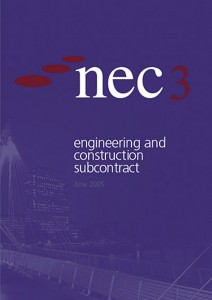Projects and Features
Making it work for you: NEC3 the engineering and construction subcontract
The NEC3 subcontract form is potentially a very effective tool for securing successful projects, says Marion Rich, Legal and Contractual Affairs Director of the BCSA, in this review.
Now in its third edition (NEC3), the Engineering and Construction Contract was first published in 1991 under the name New Engineering Contract. It is radically different from traditional construction contracts and as such has been both praised and criticised – the writer’s experience is that those who work with it like it a lot; many lawyers do not.
Recently, the contract has taken on even more importance: in July of this year, the Olympic Delivery Authority announced that it had chosen NEC3 suite of contracts to procure all fixed assets and infrastructure for the Games.
The speakers gathered to run the seminar were outstanding in the breadth and depth of their knowledge: in the chair was Professor Rudi Klein, well known for his trenchant articles in the trade press and – along with other duties – Chairman of the NEC Users’ Group. Also speaking were: Robert Gerrard, ex-Chairman of the Users’ Group and now secretary of it; Paul Morrison, Commercial Director of Conder Structures Ltd; Simon Boyd, Contracts Director of John Reid & Sons (Strucsteel) Ltd and James Davison, part of the legal support team of Cyril Sweett, the construction consultant.
Many thanks are due to the speakers, on whose presentations the writer has drawn extensively in the preparation of this article. In this article, the subcontract is referred to as ECS and the family of forms in general as NEC.
So what is NEC?
Well, one thing NEC is not is a construction contract that can be put in a drawer and forgotten about. This suite of contracts does far more than merely define legal relationships: instead, it can be seen as implementing sound project management principles. It works best to think of it as a management tool within a legal framework.
NEC contracts are modular in format in that there are a number of core clauses with a selection of bolt-on Options – both Main Options and Secondary Options. Main Options deal with different pricing options that change the balance of financial risk between the parties (in ECS, priced subcontract with activity schedule, priced subcontract with bill of quantities, target subcontract with activity schedule, target subcontract with bill of quantities, cost reimbursable).
There are two other Main Options, dealing with dispute resolution – one is for use if the ‘Construction Act’ applies (i.e., within the UK), one where it does not (outside the UK).
There is no standalone form for design and build work, but NEC works with either traditional engineer-led procurement or with D&B.
Secondary Options deal with a number of variables and as many as required can be chosen for each project.
NEC itself is not a partnering contract although it does encourage collaborative working. One of the options, Option X12 is a partnering option and if that appears in ECS, it makes the subcontractor part of the project team.
The NEC family of contracts is famous for its obligation to work ‘in a spirit of mutual trust and cooperation’: Robert Gerrard defines this as meaning, in effect, tell the truth and be cooperative.
NEC genuinely aims at clarity and flexibility. It claims to have no cross-references but you might find you still need to have a finger in several pages as you are reading it!
A number of public sector clients already use NEC. One persistent problem, however, is that what happens at main contract level does not always get accurately translated down the chain: outdated methods of working get in the way and prompt page after page of amendments that simply pass all the risk on to the next party. Everyone – from the client down – needs to make sure that this does not happen. Risk is dealt with in a carefully balanced way in NEC and it does no-one any good to tamper with it to such a great extent. Additional conditions (the infamous Z clauses) should be used sparingly where genuinely required by the project.
Guidance Notes, Flow Charts and a guide for users all provide invaluable support for the user.
Key Characteristics
The key characteristics of the ECS are:
• Subcontract Works Information
The Works Information specifies and describes the subcontract works and states any constraints on how the Subcontractor works. It is absolutely vital to getting the contract right.
• Early Warning
This provides that the Contractor and Subcontractor have a duty to notify each other if either becomes aware of a matter which could increase the price, delay completion or the meeting of a key date or impair the performance in use of the subcontract works. The Early Warning system can be regarded as the ‘jewel in the crown’ of NEC, buying time to deal with problems as early as possible in the interest of the project. Its purpose is not to shift the burden of liability from one party to another.
• Time Control
In NEC, the programme is a living document to be kept under review and updated. For each problem or issue, it asks the question, ‘what effect will this have on the project?’ The programme thus becomes an essential management tool.
• Compensation Events
Unlike many contracts, NEC deals with time and cost events in one process. Ascertaining loss and expense in advance may be difficult but, again, the contract is promoting real time project management.
• Risk Register
This is the Contractor’s and Subcontractor’s opportunity to let the other party know what risk factors will affect their work. It is thus of paramount importance. Again, it is a living document and will be updated as and when necessary as part of the Early Warning System.
Subcontract Data Part II
This part of the ECS deals with data provided by the Subcontractor: it is vital for this to be completed correctly and comprehensively if the specialist is to realise the full benefits of the form and so requires serious thought to ensure that the particular circumstances of each specialist are properly set out.
Pitfalls
It is perhaps unfair to refer to pitfalls but NEC3 has a different way of doing things and it is vital to get to grips with the contract – read it and then read it again, the core clauses are not very long. This might seem like a lot of work but there are rewards to be won for using the contract correctly. In every aspect of the contract, it is important to ensure that the procedures and philosophy behind NEC3 are understood.
Getting the best from NEC depends greatly on investing the time and effort at the very beginning to ensure that all documents are correctly completed. It is a very administrative and process based contract with consequences for failure to follow the procedure. Matters cannot be left: it is important to notify the other party of any issue early. This enables the other party, if it wishes, to disagree: then the problem can either be solved or a swift visit arranged to an adjudicator.
Conclusion
All these things really direct the user of ECS to one conclusion: the key is to be clear, transparent and upfront. The contract is a deliberate attempt to promote good, clear, open project management and to seek swift solutions to problems.
Provided ECS is set up properly and implemented properly, there is no doubt it is an excellent management tool that will be invaluable in producing a good result – for both the project and the parties.










